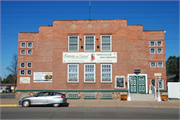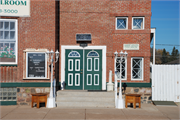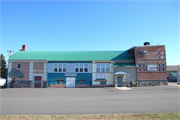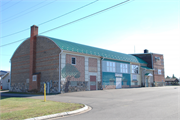Florence Town Hall
748 Central Avenue, Town of Florence, Florence County
Architect: Max L. Hanisch, Sr.
Date of Construction: 1937
The Florence Town Hall was designed in the Art Moderne style and constructed in 1937 as a Works Progress Administration (WPA) project. The building is two stories at the front and constructed of brick, the rear of the building is one story and constructed of concrete block. The Town Hall was the center of community life; the front portion provided offices and meeting rooms for the Town of Florence elected officials and employees, while the rear portion housed a large auditorium for events.
The building is an excellent example of the Art Moderne style applied to a municipal building but the auditorium is the building's most memorable space. The double-height room has a stage at one end and an expansive, arched, wood ceiling. Large, arched, wood beams emphasize the graceful curve of the ceiling and the beams themselves are one of the most important artistic features of the room. The beams are engineered from a technology the architect, Max L. Hanisch, Sr., pioneered called glued, laminated, structural wood beam construction, commonly referred to as glulam. The strength of these beams precluded any need for columns to support the ceiling which in turn created the expansive feeling of the space. The glulam beams in the Florence Town Hall are an early example of this construction technique.
Max L. Hanisch, Sr. was a native of Germany, and already a well-established architect when he emigrated in 1923. He built a successful architectural practice in Wisconsin and others of his designs are listed in the National Register of Historic Places including the Eagle River Stadium in Eagle River, Wisconsin, and the Art Deco style Marinette County Courthouse in Marinette, Wisconsin. He is best known for having introduced glulam construction to the United States and for co-founding Unit Structures, Inc. of Peshtigo, Wisconsin in 1934, which pioneered glulam manufacturing in this country. |





